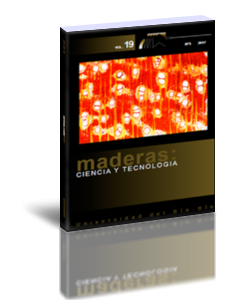Improvement of the durability of heat-treated wood against termites
Keywords:
Chemical modification, decay, durability, Fagus sylvatica, Pinus sylvestris, Reticulitermes flavipes, thermal treatment.Abstract
Thermal modification is an attractive alternative to improve the decay durability and dimensional stability of wood. However, thermally modified wood is generally not resistant to termite attacks, limiting the field of application of such materials. One way to overcome this drawback is to combine thermal modification treatment with an additional treatment. One such treatment is the impregnation of a boron derivative associated with appropriate vinylic monomers, which takes advantage of the thermal treatment to polymerise these monomers for boron fixation. Using this strategy, we recently showed that an impregnation of borax (2 or 4% boric acid equivalent) dissolved in a 10% aqueous solution of polyglycerolmethacrylate followed by thermal treatment under nitrogen at 220°C protects wood from both termite and decay degradations, even after leaching. Additionally, wood samples treated with a 10% polyglycerolmethacrylate aqueous solution and subjected to thermal treatment at 220°C presented improved resistance to termites while avoiding boron utilization. Based on these results, we investigate the effect of impregnation with two types of vinylic monomers, which are already used in the presence of boron, followed by thermal treatments at different temperatures. We evaluate termite and decay durability of wood to evaluate if thermal modification associated with light chemical modification could be a solution for utilization of thermally modified materials in termite-infested areas.Downloads
References
Bravery, A.F. 1979. A miniaturised wood-block test for the rapid evaluation of wood preservative fungicides. In: Screening techniques for potential wood preservative chemicals. Proceedings of a special seminar held in association with the 10th annual meeting of the IRG, Peebles 1978. Swedish Wood Preservation Institute Report No. 136. Stockholm.
Chaouch, M.; Petrissans, M.; Petrissans, A.; Gerardin, P. 2010. Utilization of wood elemental composition to predict heat treatment intensity and decay resistance of different softwood and hardwood species. Polym Degrad Stab 95: 2255-2259.
Chaouch, M.; Dumarçay, S.; Petrissans, A.; Petrissans, M.; Gerardin, P. 2013. Effect of heat treatment intensity on some conferred properties of different European softwood and hardwood species. Wood Sci Technol 47(4): 663-673.
NF X 41-569, 2014. Wood preservatives, Laboratory method for obtaining samples for analysis to measure losses by leaching water or synthetic sea water. French standardization committee.
European committee for standardization. 1986. Wood preservatives - determination of toxic values of wood preservatives against wood destroying basidiomycetes cultured on agar medium. EN 113.
European committee for standardization. 2013. Wood preservatives - Determination of toxic values against Reticulitermes species (European termites) (laboratory method). EN 117.
Esteves, B.M.; Pereira, H.M. 2009. Wood modification by heat treatment - A review. Bioresources 4(1): 370-404.
Gascón-Garrido, P.; Oliver-Villanueva, J.V.; Ibiza-Palacios, M.S.; Militz, H.; Mai, C.; Adamopoulos, S. 2013. Resistance of wood modified with different technologies against Mediterranean termites (Reticulitermes spp.). Int Biodeter Biodegr 82: 13-16.
Gérardin, P. 2016. New alternatives for wood preservation based on thermal and chemical modification of wood - a review. Annals of Forest Science. 73(3): 559-570.
Hakkou, M.; Petrissans, M.; Gerardin, P.; Zoulalian, A. 2005. Investigations of the reasons for fungal durability of heat-treated beech wood. Polymer Degradation and Stability 91(2): 393-397.
Militz, H. 2002. Thermal treatment of wood: European processes and their background, The International Research Group on Wood Preservation. IRG/WP 02-40241.
Mburu, F.; Dumarçay, S.; Huber, F.; Petrissans, M.; Gerardin, P. 2007. Evaluation of thermally modified Grevillea robusta heartwood as an alternative to shortage of wood resource in Kenya: Characterisation of physicochemical properties and improvement of bio-resistance. Bioresour Technol 98: 3478-3486.
Roussel, C.; Marchetti, V.; Lemor, A.; Wozniak, E.; Loubinoux, B.; Gerardin P. 2001. Chemical modification of wood by polyglycerol /maleic anhydride treatment. Holzforschung 55:57-62.
Salman, S.; Petrissans, A.; Thevenon, M.F.; Dumarçay, S.; Perrin, D.; Pollier, B.; Gerardin, P. 2014. Development of new wood treatments combining boron impregnation and thermo modification - Effect of additives on boron leachability. Eur J Wood Prod 72: 355-365.
Salman, S.; Petrissans, A.; Thevenon, M.F.; Dumarçay, S.; Gerardin, P. 2016. Decay and termites resistance of pine blocks impregnated with different additives and subjected to heat treatment. Eur J Wood Prod 74: 37-42.
Shi, J.L.; Kocaefe, D.; Amburgey, T.; Zhang, J.L. 2007. A comparative study on brown-rot fungus decay and subterranean termite resistance of thermally-modified and ACQ-C-treated wood. Holz als Roh und Werstoff 65(5): 353-358.
Sivrikaya, H.; Can, A.; De Troya, T.; Conde, M. 2015. Comparative biological resistance of differently thermal modified wood species against decay fungi, Reticulitermes grassei and Hylotrupes bajulus. Maderas-Cienc Tecnol 17(3): 559-570.
Soulounganga, P.; Marion, C.; Huber, F.; Gerardin, P. 2003. Synthesis of Polyglycerol Methacrylate and its Application to Wood Dimensional Stabilization. J Appl Polym Sci 88: 743-749.
Surini, T.; Charrier, F.; Malvestio, J.; Charrier, B.; Moubarik, A.; Castéra, P.; Grelier, S. 2012. Physical properties and termite durability of maritime pine Pinus pinaster Ait heat-treated under vacuum pressure. Wood Sci Technol 46: 487-501.
Wang, C.L.; Lin, T.S.; Li, M.H. 2002. Decay and termites resistance of planted tree sapwood modified by acetylation. Taiwan Journal of Forest Science 17(4): 483-490.
Welzbacher, C.; Brischke, C.; Rapp, A. 2007. Influence of treatment temperature and duration on selected biological, mechanical, physical and optical properties of thermally modified timber. Wood Material Science and Engineering 2(2):66-7.
































